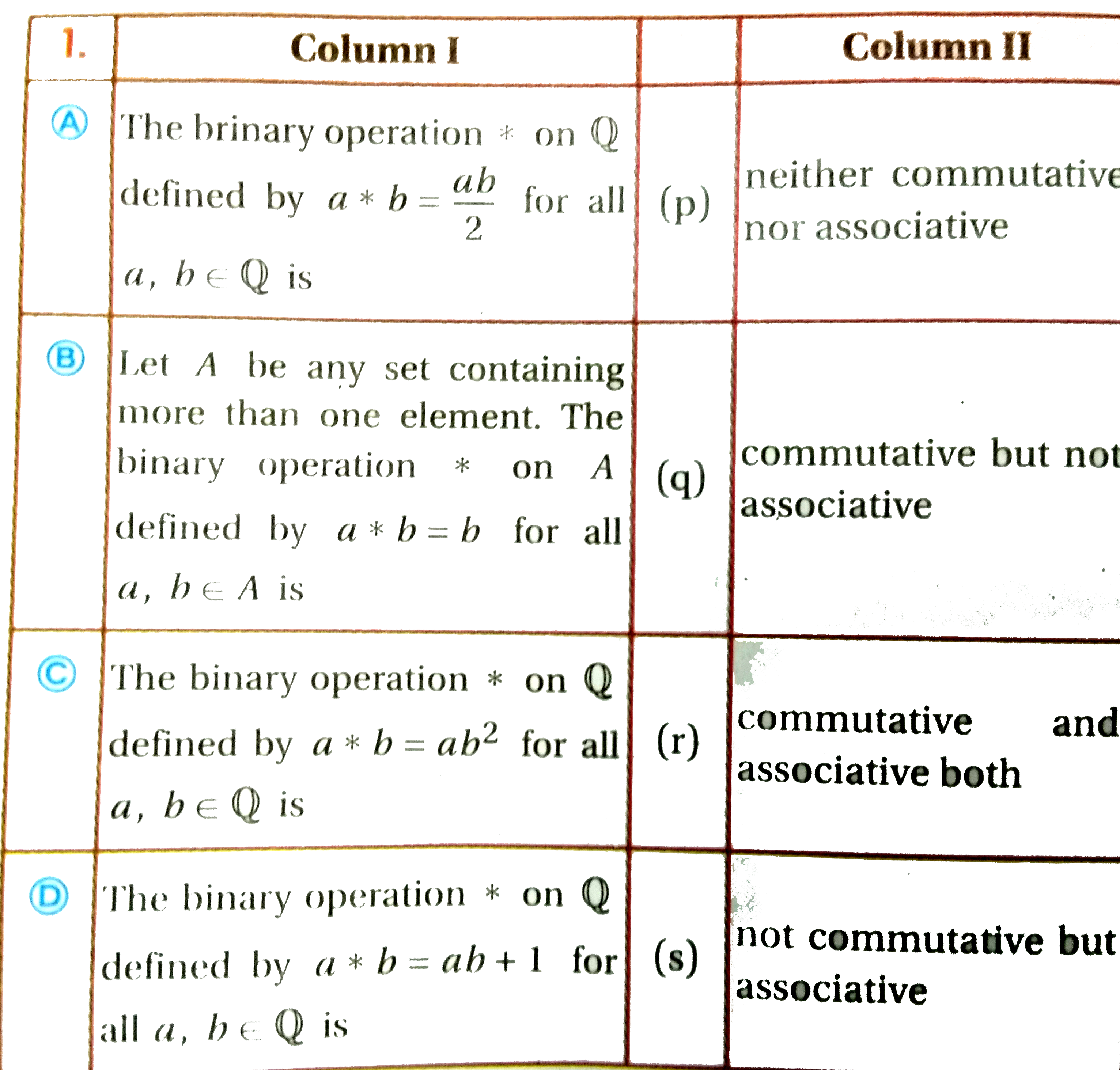Let be a binary operation on set defined by e is the identity element with respect to on . Every element of is invertible, then value of and inverse of an element are---Solution in Bengali
0
1
The correct Answer is:A,C
Step by step video, text & image solution for Let ** be a binary operation on set QQ-{1} defined by a**b=a+b-abinQQ-{1}. e is the identity element with respect to ** on QQ. Every element of QQ-{1} is invertible, then value of e and inverse of an element a are--- by Maths experts to help you in doubts & scoring excellent marks in Class 12 exams.
Updated on:21/07/2023Topper's Solved these Questions
- BINARY OPERATIONBOOK - CHHAYA PUBLICATIONCHAPTER - BINARY OPERATIONEXERCISE - Integar Answer Type
5 Videos
- BINARY OPERATIONBOOK - CHHAYA PUBLICATIONCHAPTER - BINARY OPERATIONEXERCISE - Matrix Match Type
2 Videos
- BINARY OPERATIONBOOK - CHHAYA PUBLICATIONCHAPTER - BINARY OPERATIONEXERCISE - EXERCISE 3 (Long Answer Type Questions)
22 Videos
- ARCHIVEBOOK - CHHAYA PUBLICATIONCHAPTER - ARCHIVEEXERCISE - JEE Advanced Archive
13 Videos
- BINOMIAL DISTRUTIONBOOK - CHHAYA PUBLICATIONCHAPTER - BINOMIAL DISTRUTIONEXERCISE - ASSERTION-REASON TYPE
2 Videos
Similar Questions
Let S={a,b,c}, the total number of binary operations on S be K9. Find the value of K.
View SolutionMatch the following Column I and Column II

View SolutionA binary operation ∘ is defined on R−{−1} by a∘b=a+b+ab for all a,b∈R−{−1}.
(i) Discuss the commutativity and associativity of ∘ on R−{−1}.
Find the identity element, if exists.
(iii) Prove that every element of R−{−1} is invertible.
View SolutionFour persons independently solve a certain problem correctly with probabilities,12,34,14,18 Then the probability that problem is solved correctly by at least one of them is-
View SolutionStatement-I: Under some condition in the random experiment, p and q are the probability of 'success' and probability of 'failure' respectively, then the probability for x success is f(x)=nCxpxqn−x(x=0,1,2,......,n)
Statement-II: Sample space of a random experiment has only two sample points one is success and other is failure.
View SolutionDefine a binary operation ∗ on the set A={0,1,2,3,4,5} as a∗b=(a+b) (mod6). Show that zero is the identity for this operation and each element a of the set is invertible with 6−a being the inverse of a.
OR
A binary operation ∗ on the set {0,1,2,3,4,5} is defined as a∗b={a+bifa+b<6a+b−6ifa+b≥6} Show that zero is the identity for this operation and each element a of the set is invertible with 6−a , being the inverse of a.
View SolutionLet * be a binary operation on set Q−[1] defined by a⋅b=a+b−ab for alla,b∈Q−[1]. Find the identity element with respect to ⋅onQ. Also, prove that every element of Q−[1] is invertible.
View SolutionLet * be an associative binary operation on a set S with the identity element e in S. Then. the inverse of an invertible element is unique.
View SolutionLet Q be the set of rational numbers, If f:Q→Q is defined by f(x)=ax+b , where a, b, x∈Q and a≠0, then show that f is invertible and hence find f−1
View SolutionIs ∘ defined on Q the set of rational numbers, by a∘b=a−1b−1(a,b∈Q), a binary operation?
View SolutionProve that the binary operation ∘ defined on Q by a∘b=a−b+ab for all a,b in Q is neither commutative nor associative.
View Solutionlet ∗ be a binary on Q, defined by
a∗b=(a−b)2 for all a,b∈Q. Show that the binary operation ∗ on Q is commutative but not associative.
View SolutionAn operation ∘ on Q−{−1} is defined by a∘b=a+b+ab for a,b∈Q−{−1}. Find the identity element e∈Q−{−1}.
View SolutionOn the set Q+ of all positive rational numbers if the binary operation ∗ is defined by a∗b=14ab for all a,b∈Q+, find the identity element in Q+. Also prove that any element in Q+ is invertible.
View SolutionQ+ denote the set of all positive raional numbers. If the binary operation ∘ on Q+ is defined as a∘b=ab2, then the inverse of 3 is---
View Solution
